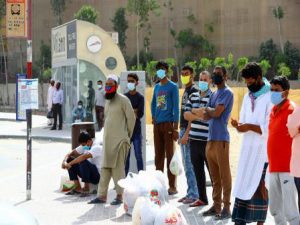COVID-19 and International Migration Governance
COVID-19 pandemic has forced every country in the world, including countries of destination and major countries of origin, to rethink the approach towards migration and migrants.

Global migration scenario was discussed and debated in the past decade more than ever. The rapid increase in human mobility across international borders has various social, economic and political implications. The concerns related to migration are increasingly politicised by various actors such as governments and international media. Notable incidents in the decade include the mass movement of people from African countries to Europe, the refugee movement in the Bay of Bengal and the human rights violations faced by the labour migrants in the Gulf countries, especially the recent controversies about the World Cup preparations in Qatar. All these have literally forced the state and non-state actors to find ways to manage migration globally using international institutions. Nation states have also recognised that they cannot manage the migration question without international co-operation. As a result, with the support of UN organisations and various governments, member countries adopted Global Compact for Migration (GCM) and Global Compact for Refugees (GCR) in 2018. These non-binding agreements aim to better manage migration at local, national, regional and global levels, including reducing the risks and vulnerabilities migrants or refugees face at different stages of their journey.
The process of adoption of these compacts initiated after the historic New York Declaration for Refugees and Migration in 2016. They managed to bring together all major governments and non-government actors to work for the common goal. In 2019, countries and global institutions launched the initial activities towards the implementation of the objectives of these compacts. All these activities in the current decade have developed the route towards a unified approach on international migration management regime which would help countries to overcome the questions of sovereignty and lack of uniformity in the migration management. Moreover, the nation states, international institutions and the non-state actors such as NGOs, recruitment agencies, etc. agreed on certain common goals and identified the importance of fostering partnerships at various levels of governance. All these developments were leading towards a multi-layered migration governance model in which all stakeholders have important roles to play. It brought smiles to everyone who wished for well-being of the migrants and society. However, the current global health crisis brought by the COVID-19 pandemic would definitely alter all the hard-earned togetherness and unification of stakeholders. Every country in the world, including countries of destination and major countries of origin, is forced to rethink the approach towards migration and migrants.
Also Read : Migrant Workers From The Gulf An Exodus That Cant Be Downplayed
Impact of COVID-19 on International Migration Governance
The expected collapse of all the above-mentioned achievements will be the primary development in the world of migration.
The immediate changes will be countries’ withdrawal from the compacts, stringent visa regimes, reduction in the number of permanent citizenships offered and the introduction of new quota systems for the foreign labourers.
In this current scenario, there will be a zero-mobility of migrants at least for the next six months. Countries will use this time to frame long-term admission schemes and stringent-migration management regimes. Simultaneously, migrants and refugees will be increasingly vulnerable at the destination countries and the governments will not be ready for any global association by citing the impact of the crisis on the local economy and people. We are yet to predict how steep the fall in the numbers of international migrants in the post-COVID-19 period. There will definitely be fever regular migration opportunities. The large flow of undocumented migrants in the pre-COVID-19 era was mainly due to the socio-economic inequalities and political crises. These factors will be strengthened further in the post-pandemic period and more migrants may prepare themselves ready to move illegally in search of better opportunities. The contradiction between limited number of job opportunities, tightening of borders and looming economic crises in most part of the world might lead to large-scale distress migration and human rights violations.
Another aspect of importance is the cost of migration. The expected decrease in the number of opportunities and increase in demand for job would unquestionably increase the cost of migration. The origin country government’s major focus will be on rebuilding the economies rather than strengthening migration management at least for a few years. This will help the already existing middle men and illegal recruitment agents to flourish. As a result, cost of migration and the number of undocumented workers will increase. On a positive note, we could argue that the crisis taught us how much the host country economies are relied on migrants in important occupations such as health services, care work, etc. The migrants in gulf countries and European countries have shown immense courage to fight for the society, which provides them employment.

In the destination countries, especially in the developed countries, the existing xenophobia and racism towards the permanent migrants, refugees and migrant workers will eclipse multiple times. The countries, which are following the refugee conventions of UNHCR, may reduce the number of refugee intake and shut down the refugee camps. Countries and rulers would definitely be influenced by the national sovereignty than the global co-operation for better migration governance. The countries, which receive large number of temporary labour migrants and circular migrants, such as GCC countries, Singapore and Malaysia, face a much bigger challenge ahead. Since these countries are greatly depend up on the migrants in all aspects of life, a rethinking in the strategy would not be easier. However, the nationalisation programmes and the existing attempts to increase automation in key sectors in the destination countries have provided the governments a background on how to plan themselves for the immediate future with less-available migrant workforce. One of the major destinations of temporary migrant workers, the GCC countries which are already experiencing economic crisis due to the oil price shocks will trim down the existing workforce once the travel bans are lifted. Even though governments have announced measures for wage protection for the migrant workers, employers may not be able to sustain with huge financial burden in the long run. The lack of social security agreements and welfare support systems such as insurance for the migrant workers pushed them into a situation of concern. However, the construction workers, care workers and health service professionals among migrants will remain as the most sought-after professions in those countries. In the long-run these countries still may require the service of migrants. Less number of jobs and strict skill-certification and health check-ups will be mandatory for the future migrants to these countries. The gulf countries have not signed many bilateral/multilateral agreements with international institutions or the origin countries. By citing the looming crisis, those governments will stay away from signing any pro-migrant agreement or implementing the objectives of GCM.
The pandemic is a real setback for the countries of origin (COO), especially for the countries which worked tirelessly to bring stakeholders together to develop new governance frameworks and global compacts. Regarding the permanent movement of people, COO have nothing much to offer than preventing the illegal movement of people and better opportunities for the people. Many origin countries may go for options such as diaspora bonds to bring support from the diaspora in order to recover from the economic shocks. However, the need of the hour is to ensure the well-being of their citizens in the destination countries. The countries without pro-migrant migration governance system are failing to meet the needs of the citizens abroad. A few countries are preparing themselves for the large-scale return of the citizens after the global lockdown. Governments alone cannot manage the large-scale reintegration. A collective of government, political parties, civil society organisations, recruiters and other stakeholders are important for the effective reintegration. International organisations are yet to assist countries on developing repatriation and reintegration procedures. If those institutions are really advocating for multi-layered migration governance models, they should announce their willingness to support the countries of origin.
Also Read : Migrant Exodus During The National Lockdown
In the long-run, the ethical recruitment practices and demand for skill-oriented migration will be the norm.
The COO should work with the destination countries, international organisations and other stakeholders to understand the requirements of the destination country labour markets in the post-pandemic phase and develop comprehensive migration management strategies.
Time to Rethink India’s Migration Management Strategies
Even though India receives a good number of immigrants and refugees every year, the country is identified as the largest remittance receiver when it comes to migration. Regarding the diaspora/permanent migrants, the government will continue its pre-pandemic strategies, i.e, the state continues its attempts to receive investments from diaspora and to develop programmes to prevent brain drain from the country. These are the visible strategies adopted by the country after the revamp in migration management from the beginning of the 21st century.
The lack of explicit migration policies and bilateral/multilateral agreements to ensure the welfare of the workers in the destination countries is a feature of Indian migration governance regime over the years. The lack of support systems and poor crisis management led to the massive demand for repatriation during the crises. However, we should appreciate the response from the Indian missions for bringing together Indian non-state actors in relief activities. Such strategies are necessary within the country when the international migrants return to the home country. Apart from developing sustainable reintegration programmes with the support of various stakeholders, the national government should bring together major origin state governments for better management of the reintegration. The strategies at the national, state and grassroots level can ensure the effective participation and the government could push for support from UN agencies such as International Organisation for Migration (IOM) and International Labour Organisation (ILO) for identifying replicable models from other countries and for providing technical support. As the recent developments in the global migration regime envisaged, countries such as India could show the world that a multi-layered participatory approach is the best for the management of migration at least in the countries of origin during the post-COVID-19 period.
(Slider Photo credit: Amnesty.org)
